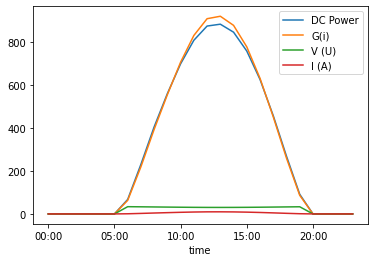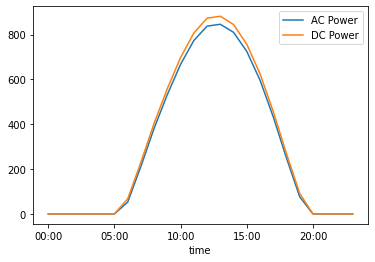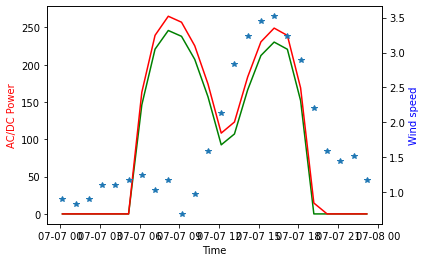A library used to simulate photovoltaic energy production using PVGIS
Project description
PV-Module
PV-Module is a Python library which focus is to simulate photovoltaic systems. This module can simulate both Monofacial & Bifacial modules.
Installation
Use the package manager pip to install foobar.
pip install pvmodule
Usage
Usage - Location
Using the city name, this method will geolocate its coordinates, elevation, timezone. To use costum locations, just input the desired parameters and they will overwrite the geolocation.
Parameters
----------
city: str
The name of the city in which the system is going to be built.
latitude: float, default = None,
A specific latitude to overwrite the automatic search.
longitude: float, default = None,
A specific longitude to overwrite the automatic search.
elevation: float, default = None,
A specific elevation to overwrite the automatic search.
This elevation corresponds to how many meters the city is above the sea-level.
timezone: str, default = None,
The timezone in which the city is located.
A specific timezone to overwrite the automatic search.
name: str, default = None,
The name of the system. This does not affect anything.
>>> from pvmodule.location import Location
>>> Location = Location()
>>> location = Location.set_location('Lisbon')
>>> print(location.get_info())
{
'Address': 'Lisboa, Portugal',
'Latitude': 38.7077507,
'Longitude': -9.1365919,
'Elevation': 10.93380069732666,
'Timezone': 'Europe/Lisbon'
}
Usage - PV Module Selection
To retrieve a list of 17000+ PV modules the following method can be used with the following parameters.
Parameters
----------
url : str, default = 'https://raw.githubusercontent.com/fabio-r-almeida/pvmodule/main/PV_Modules.csv'
Url to the list of modules. Can also be a .csv file.
wattage : int, default = None
Filter modules by a desired Wattage
BIPV : str, default = None, default values allows both bi-facial and mono-facial modules to appear in the list
Filter modules by bi-facial or monofacial modules
Bi-facial = 'Y'
Mono-facial = 'N'
>>> from pvmodule.modules import Modules
>>> Modules = Modules()
>>> module_list = Modules.list_modules()
Manufacturer Model Number Safety Certification Pmax PTC Technology A_c N_s N_p BIPV Isc Voc Ipmax Vpmax NOCT Tc_pmax Tc_isc Tc_voc Short Side Long Side
0 Ablytek 6MN6A270 UL 1703 270.0 242.1 Mono-c-Si 1.627 60.0 1.0 N 9.34 38.63 8.81 30.72 47.4 -0.4509 0.0521 -0.3137 0.992 1.64
1 Ablytek 6MN6A275 UL 1703 275.0 246.7 Mono-c-Si 1.627 60.0 1.0 N 9.42 38.97 8.88 30.99 47.4 -0.4509 0.0521 -0.3137 0.992 1.64
2 Ablytek 6MN6A280 UL 1703 280.0 251.3 Mono-c-Si 1.627 60.0 1.0 N 9.51 39.31 8.96 31.26 47.4 -0.4509 0.0521 -0.3137 0.992 1.64
3 Ablytek 6MN6A285 UL 1703 285.0 256.0 Mono-c-Si 1.627 60.0 1.0 N 9.59 39.65 9.04 31.53 47.4 -0.4509 0.0521 -0.3137 0.992 1.64
4 Ablytek 6MN6A290 UL 1703 290.0 260.6 Mono-c-Si 1.627 60.0 1.0 N 9.67 39.99 9.12 31.80 47.4 -0.4509 0.0521 -0.3137 0.992 1.64
... ... ... ... ... ... ... ... ... ... ... ... ... ... ... ... ... ... ... ... ...
17706 Zytech Solar ZT300P UL 1703 300.0 271.2 Multi-c-Si 1.931 72.0 1.0 N 8.71 45.96 8.26 36.32 46.4 -0.4308 0.0483 -0.3199 0.990 1.95
17707 Zytech Solar ZT305P UL 1703 305.0 275.8 Multi-c-Si 1.931 72.0 1.0 N 8.87 46.12 8.36 36.49 46.4 -0.4308 0.0483 -0.3199 0.990 1.95
17708 Zytech Solar ZT310P UL 1703 310.0 280.5 Multi-c-Si 1.931 72.0 1.0 N 8.90 46.28 8.46 36.66 46.4 -0.4308 0.0483 -0.3199 0.990 1.95
17709 Zytech Solar ZT315P UL 1703 315.0 285.1 Multi-c-Si 1.931 72.0 1.0 N 9.01 46.44 8.56 36.81 46.4 -0.4308 0.0483 -0.3199 0.990 1.95
17710 Zytech Solar ZT320P UL 1703 320.0 289.8 Multi-c-Si 1.931 72.0 1.0 N 9.12 46.60 8.66 37.00 46.4 -0.4308 0.0483 -0.3199 0.990 1.95
Usage - PV Inverter Selection
List of +1400 inverters provided by CEC.
Parameters
----------
url : str, default = 'https://raw.githubusercontent.com/fabio-r-almeida/pvmodule/main/CEC%20Inverters.csv'
Url to the list of inverters. Can also be a .csv file.
vac : str, default = None
Filters the results that are equal to the AC voltage output
pmax : int, default = None
Filters the results that are equal to the Max Power input
print_list : bool, default = False
Prints list of inverters
>>> from pvmodule.inverters import Inverters
>>> Inverters = Inverters()
>>> inverter_list = Inverters.list_inverters()
Name Vac Pso Paco Pdco Vdco C0 C1 C2 C3 Pnt Vdcmax Idcmax Mppt_low Mppt_high CEC_Date CEC_hybrid
0 ABB: PVI-3.0-OUTD-S-US-A [208V] 208 18.1674 3000.0 3142.30 310.0 -8.040000e-06 -0.000011 0.000999 -0.000287 0.100000 480.0 10.13650 100.0 480.0 10/15/2018 N
1 ABB: PVI-3.0-OUTD-S-US-A [240V] 240 16.8813 3000.0 3121.67 340.0 -5.700000e-06 -0.000021 0.000583 -0.000712 0.100000 480.0 9.18138 100.0 480.0 10/15/2018 N
2 ABB: PVI-3.0-OUTD-S-US-A [277V] 277 22.0466 3000.0 3106.85 390.0 -5.460000e-06 -0.000033 -0.000032 -0.001180 0.200000 480.0 7.96628 100.0 480.0 10/15/2018 N
3 ABB: PVI-3.0-OUTD-S-US-Z-A [208V] 208 18.1674 3000.0 3142.30 310.0 -8.040000e-06 -0.000011 0.000999 -0.000287 0.100000 480.0 10.13650 100.0 480.0 10/15/2018 N
4 ABB: PVI-3.0-OUTD-S-US-Z-A [240V] 240 16.8813 3000.0 3121.67 340.0 -5.700000e-06 -0.000021 0.000583 -0.000712 0.100000 480.0 9.18138 100.0 480.0 10/15/2018 N
... ... ... ... ... ... ... ... ... ... ... ... ... ... ... ... ... ...
1415 Yaskawa Solectria Solar: SGI 750XTM [380V] 380 3714.1400 753200.0 777216.00 615.0 -1.410000e-08 0.000006 0.001554 -0.000272 122.550000 820.0 1263.77000 545.0 820.0 NaN N
1416 Yaskawa Solectria Solar: XGI 1500-125/125 [600V] 600 236.8650 124618.0 126553.00 1050.0 -4.580000e-08 0.000012 0.003275 0.000547 3.842105 1250.0 120.52600 860.0 1250.0 7/21/2020 N
1417 Yaskawa Solectria Solar: XGI 1500-125/150 [600V] 600 236.8650 124618.0 126553.00 1050.0 -4.580000e-08 0.000012 0.003275 0.000547 3.842105 1250.0 120.52600 860.0 1250.0 7/21/2020 N
1418 Yaskawa Solectria Solar: XGI 1500-150/166 [600V] 600 111.3230 150000.0 152458.00 1100.0 -3.140000e-08 0.000014 0.000113 -0.000354 2.750000 1250.0 138.59800 860.0 1250.0 7/21/2020 N
1419 Yaskawa Solectria Solar: XGI 1500-166/166 [600V] 600 253.1140 165139.0 167945.00 1050.0 -5.060000e-08 0.000014 0.003122 0.000368 3.842105 1250.0 159.94800 860.0 1250.0 7/21/2020 N
Sample Usages
>>> from pvmodule.location import Location
>>> from pvmodule.pvgis import PVGIS
>>> Location = Location()
>>> location = Location.set_location('Lisbon')
>>> print(location.get_info())
{
'Address': 'Lisboa, Portugal',
'Latitude': 38.7077507,
'Longitude': -9.1365919,
'Elevation': 10.93380069732666,
'Timezone': 'Europe/Lisbon'
}
Retrieving Hourly data from PVGIS
>>> from pvmodule.location import Location
>>> from pvmodule.pvgis import PVGIS
>>> Location = Location()
>>> location = Location.set_location('Lisbon')
>>> PVGIS = PVGIS()
>>> input, output, meta = PVGIS.retrieve_hourly(
latitude=location.latitude,
longitude=location.longitude
)
>>> print(output)
G(i) H_sun T2m WS10m Int
time
2005-01-01 00:10:00 0.0 0.0 11.29 3.86 0.0
2005-01-01 01:10:00 0.0 0.0 11.19 4.14 0.0
2005-01-01 02:10:00 0.0 0.0 11.08 4.07 0.0
2005-01-01 03:10:00 0.0 0.0 10.94 3.66 0.0
2005-01-01 04:10:00 0.0 0.0 10.84 3.24 0.0
... ... ... ... ... ...
2020-12-31 19:10:00 0.0 0.0 12.50 8.28 0.0
2020-12-31 20:10:00 0.0 0.0 12.12 8.34 0.0
2020-12-31 21:10:00 0.0 0.0 11.58 8.48 0.0
2020-12-31 22:10:00 0.0 0.0 11.41 8.28 0.0
2020-12-31 23:10:00 0.0 0.0 11.36 8.14 0.0
[140256 rows x 5 columns]
Retrieving daily data from PVGIS (July)
>>> from pvmodule.location import Location
>>> from pvmodule.pvgis import PVGIS
>>> Location = Location()
>>> location = Location.set_location('Lisbon')
>>> PVGIS = PVGIS()
>>> input, output, meta = PVGIS.retrieve_daily(
latitude=location.latitude,
longitude=location.longitude,
month=6
)
>>> print(output)
month G(i) Gb(i) Gd(i) T2m
time
00:00 6 0.00 0.00 0.00 17.49
01:00 6 0.00 0.00 0.00 17.35
02:00 6 0.00 0.00 0.00 17.21
03:00 6 0.00 0.00 0.00 17.09
04:00 6 0.00 0.00 0.00 16.98
05:00 6 0.00 0.00 0.00 16.91
06:00 6 88.17 36.65 51.52 16.97
07:00 6 244.22 136.17 108.05 17.53
08:00 6 406.34 251.83 154.51 18.42
09:00 6 560.33 366.56 193.77 19.39
10:00 6 691.23 479.46 211.78 20.29
11:00 6 788.61 558.10 230.51 21.05
12:00 6 869.24 632.05 237.19 21.59
13:00 6 877.81 644.56 233.24 21.88
14:00 6 828.50 609.14 219.36 21.92
15:00 6 738.56 540.56 198.01 21.75
16:00 6 594.07 420.05 174.01 21.38
17:00 6 426.24 280.32 145.91 20.88
18:00 6 244.49 141.33 103.16 20.25
19:00 6 82.36 35.16 47.20 19.45
20:00 6 0.00 0.00 0.00 18.68
21:00 6 0.00 0.00 0.00 18.18
22:00 6 0.00 0.00 0.00 17.90
23:00 6 0.00 0.00 0.00 17.69
Retrieving Monthly data from PVGIS (July)
>>> from pvmodule.location import Location
>>> from pvmodule.pvgis import PVGIS
>>> Location = Location()
>>> location = Location.set_location('Lisbon')
>>> PVGIS = PVGIS()
>>> input, output, meta = PVGIS.retrieve_monthly(
latitude = location.latitude,
longitude = location.longitude,
startyear=2020,
endyear=2020
)
>>> print(output)
year month H(h)_m Hb(n)_m Kd T2m
0 2020 1 71.23 107.98 0.42 12.8
1 2020 2 98.98 131.26 0.38 13.8
2 2020 3 147.58 168.06 0.36 13.7
3 2020 4 157.34 145.53 0.42 14.8
4 2020 5 218.93 220.23 0.31 18.1
5 2020 6 231.53 235.23 0.30 18.7
6 2020 7 244.94 261.47 0.26 21.2
7 2020 8 208.59 217.80 0.30 20.6
8 2020 9 159.27 167.80 0.36 20.3
9 2020 10 117.98 143.74 0.39 17.1
10 2020 11 68.78 81.66 0.52 15.4
11 2020 12 63.66 93.93 0.46 12.9
from pvmodule.system import System
Defining the module setup
>>> from pvmodule.system import System
#if nothing is input, it will consider the default module with its parameters.
>>> system = System()
>>> module = system.module(modules_per_string=3)
>>> print(module)
{
"name": "LG_Neon_2_ LG350N1C-V5",
"height": 1.686,
"length": 1.016,
"width": 40,
"pdc": 350,
"umpp": 35.3,
"impp": 9.92,
"uoc": 41.3,
"isc": 10.61,
"NOCT": 42,
"tc_pmax": -0.36,
"tc_voc": -0.27,
"tc_isc": 0.03,
"modules_per_string": 3,
"number_of_strings": 1,
"losses": 0,
}
Calculating the DC power generated by the previous module setup.
>>> from pvmodule.pvgis import PVGIS
>>> input, output, metadata = PVGIS().retrieve_daily(
location.latitude,
location.longitude,
month=7
)
>>> from pvmodule.system import System
>>> system = System()
>>> system_dc = system.dc_production(module, output['T2m'], output['G(i)'])
>>> print(system_dc)
>>> import matplotlib.pyplot as plt
>>> system_dc.plot()
DC Power G(i) V (U) I (A)
time
00:00 0.000000 0.00 0.000000 0.000000
01:00 0.000000 0.00 0.000000 0.000000
02:00 0.000000 0.00 0.000000 0.000000
03:00 0.000000 0.00 0.000000 0.000000
04:00 0.000000 0.00 0.000000 0.000000
05:00 0.000000 0.00 0.000000 0.000000
06:00 67.326169 62.96 33.595611 0.668006
07:00 230.488507 219.26 33.025791 2.326349
08:00 404.612107 392.92 32.351774 4.168881
09:00 559.303225 554.33 31.698762 5.881441
10:00 697.667399 705.17 31.082645 7.481854
11:00 806.834702 829.20 30.569521 8.797812
12:00 872.878407 907.01 30.234656 9.623376
13:00 881.502513 918.44 30.153389 9.744648
14:00 844.397024 876.07 30.281072 9.295103
15:00 756.681707 776.12 30.630051 8.234633
16:00 624.646497 629.87 31.156362 6.682921
17:00 456.489476 450.85 31.809882 4.783519
18:00 268.290990 259.17 32.522560 2.749794
19:00 91.263308 86.35 33.204521 0.916173
20:00 0.000000 0.00 0.000000 0.000000
21:00 0.000000 0.00 0.000000 0.000000
22:00 0.000000 0.00 0.000000 0.000000
23:00 0.000000 0.00 0.000000 0.000000
Calculating the AC power generated by the previous module setup.
Using a default CECinverter from an included list.
>>> system = System()
#Wind consideration can be included
#system_ac = system.ac_production(module, output['T2m'], output['G(i)'], inverter, wind=True, wind_speed=output['WS10m'])
#system_dc_wind = system.dc_production(module, output['T2m'], output['G(i)'],wind=True, wind_speed=output['WS10m'], temp=True)
>>> inverter_list = system.list_inverters()
>>> inverter = system.select_inverter('ABB: PVI-3.0-OUTD-S-US-A [240V]')
>>> system_ac = system.ac_production(module, output['T2m'], output['G(i)'], inverter)
>>> print(system_ac)
>>> import matplotlib.pyplot as plt
>>> system_ac.plot()
AC Power DC Power
time
00:00 0.000000 0.000000
01:00 0.000000 0.000000
02:00 0.000000 0.000000
03:00 0.000000 0.000000
04:00 0.000000 0.000000
05:00 0.000000 0.000000
06:00 52.413461 67.326169
07:00 212.138796 230.488507
08:00 382.184273 404.612107
09:00 532.896349 559.303225
10:00 667.417007 697.667399
11:00 773.361940 806.834702
12:00 837.374717 872.878407
13:00 845.728999 881.502513
14:00 809.776551 844.397024
15:00 724.710137 756.681707
16:00 596.458487 624.646497
17:00 432.766025 456.489476
18:00 249.094402 268.290990
19:00 75.872365 91.263308
20:00 0.000000 0.000000
21:00 0.000000 0.000000
22:00 0.000000 0.000000
23:00 0.000000 0.000000
>>> from pvmodule.location import Location
>>> from pvmodule.system import System
>>> from pvmodule.simulation import Simulation
>>> location = Location().set_location('Covilhã')
>>> module = System().module()
>>> list_inverter = System().list_inverters()
>>> inverter = System().select_inverter('ABB: PVI-3.0-OUTD-S-US-A [240V]',list_inverter)
>>> output, degradacao = Simulation().simulate_vertical(module, inverter, location, duration=15, startyear=2020)
>>> import matplotlib.pyplot as plt
>>> output = output[output.index.month == 7]
>>> output = output[output.index.day == 7]
>>> fig, ax1 = plt.subplots()
>>> ax2 = ax1.twinx()
>>> ax1.plot(output.index, output['AC Power'], 'g-')
>>> ax2.plot(output.index, output['Wind Speed'], '*')
>>> ax1.plot(output.index, output['DC Power'], 'r-')
>>> ax1.set_xlabel('Time')
>>> ax1.set_ylabel('AC/DC Power', color='r')
>>> ax2.set_ylabel('Wind speed', color='b')
>>> plt.show()
Versions
All notable changes to this project will be documented in this file.
[0.0.34] - 2023-01-31
Added
- Added new class to calculare front and rear irradiance.
- Resolved minor bugs.
- Corrected/updated formulas to calculate spacing between modules.
Contributing
Pull requests are welcome. For major changes, please open an issue first to discuss what you would like to change.
Please make sure to update tests as appropriate.
License
Copyright
Copyright (c), 2023, Fabio Ramalho de Almeida
Permission is hereby granted, free of charge, to any person obtaining a copy of this software and associated documentation files (the "Software"), to deal in the Software without restriction, including without limitation the rights to use, copy, modify, merge, publish, distribute, sublicense, and/or sell copies of the Software, and to permit persons to whom the Software is furnished to do so, subject to the following conditions:
The above copyright notice and this permission notice shall be included in all copies or substantial portions of the Software.
THE SOFTWARE IS PROVIDED "AS IS", WITHOUT WARRANTY OF ANY KIND, EXPRESS OR IMPLIED, INCLUDING BUT NOT LIMITED TO THE WARRANTIES OF MERCHANTABILITY, FITNESS FOR A PARTICULAR PURPOSE AND NONINFRINGEMENT. IN NO EVENT SHALL THE AUTHORS OR COPYRIGHT HOLDERS BE LIABLE FOR ANY CLAIM, DAMAGES OR OTHER LIABILITY, WHETHER IN AN ACTION OF CONTRACT, TORT OR OTHERWISE, ARISING FROM, OUT OF OR IN CONNECTION WITH THE SOFTWARE OR THE USE OR OTHER DEALINGS IN THE SOFTWARE.
Project details
Release history Release notifications | RSS feed
Download files
Download the file for your platform. If you're not sure which to choose, learn more about installing packages.
Source Distribution
Built Distribution
Hashes for pvmodule-0.0.35-py3-none-any.whl
| Algorithm | Hash digest | |
|---|---|---|
| SHA256 | 058d6b83d36e20d3c045977504a59f01746d65f13fc7d31b87ed66694723b253 |
|
| MD5 | b3bf0e0a5c35144fd000bc7140c3814c |
|
| BLAKE2b-256 | 587f657ccd8d3b4cae85882aa313294cd92fafb4262d3f8d90111b111e24c635 |














